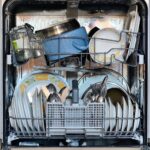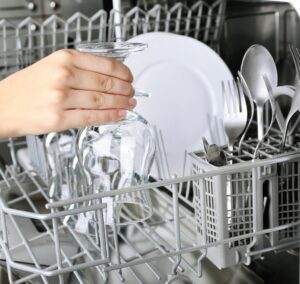You’ve just finished hosting lots of friends and family for a huge dinner party. Now you’re left to clean the dirty dishes, utensils, and cooking supplies. You decide that you can save time by stuffing as many items as possible into your dishwasher. After all, you want to call it a night sooner rather than later.
When that first load finishes, you are appalled to find that barely any of the items you put in your dishwasher are clean. What you’ve just done is overload your dishwasher, keeping it from thoroughly and effectively cleaning your cooking items and kitchenware. However, you can learn how to avoid overloading the dishwasher, so all your items can come out squeaky clean after just one cycle.
How To Avoid Overloading The Dishwasher: 7 Tips & Tricks
Any of these seven tips and tricks will help you avoid overloading the dishwasher. Although some of these strategies might require multiple loads, you’ll appreciate not having to put the same dishes and utensils in the dishwasher multiple times. These techniques will ultimately save you time and stress.
1. Know What Goes In The Top And Bottom Racks
Before you can even begin loading the dishwasher, you need to know what goes in the top and bottom racks. If you want to get the most out of your dishwasher’s abilities, you’ll need to be deliberate with what items you put in the racks. In the top rack, you’ll store glasses, mugs, and small bowls.
Large bowls, plates, pots, and pans, on the other hand, will go in the bottom rack. This placement will give you a head start on making the best use of this appliance. To maximize water flow, mix up the size order of the larger plates between each set of tines.
2. Be Strategic With The Utensil Holder
You’ve probably been tempted to shove all the utensils into the utensil holder all at once, but that actually prevents them from being cleaned. Instead, you need to be strategic about how you place items in your utensil holder. That’s because you want to ensure there is sufficient space between each item placed in the holder.
This space will allow the detergent to get into every part of each utensil. You also shouldn’t put large utensils into the utensil holder, as they can easily block the sprayers. Instead, you’ll lay these items down flat on the top rack if there is room.
3. Handwash Large, Bulky Items
If there isn’t any room on the top rack for large utensils like mixing spoons and spatulas, you can handwash them along with other large, bulky items. You want to prioritize cleaning the small and medium items first, so wait until you see if it makes sense to include anything large before loading them. If there is room, put items like cutting boards, pots, and pans on the sides or in the back of the bottom rack, never in the front. Don’t forget to see if large items are dishwasher safe because if they aren’t, you already know what can be designated for handwashing.
4. Keep Glasses In Between The Tines
A common mistake that people make when loading the dishwasher is to put glasses on the tines. Instead, you want to keep the glasses in between the tines and only on the top rack. Trying to crowd glasses together by placing them on top of the tines can cause them to start breaking apart and even damage the tines if you aren’t careful.
5. No Large Knives Or Wooden Spoons
Two other items that you can designate for handwashing are large knives and wooden spoons. Running either of these things through the dishwasher will damage their structural integrity, so the best course of action is to handwash. With fewer items to worry about dishwashing, you can further avoid loading the dishwasher.
6. No Sharing Tines
Another way to avoid overloading the dishwasher is to let each item have its own tines. In other words, don’t place multiple items in the same set of tines. Each plate, bowl, pot, pan, and container should have its own set of tines with enough room for effective water flow.
7. Run Two Loads
Finally, if you have an overwhelming amount of dirty dishes and kitchen items, you can easily avoid overloading the dishwasher by running two loads. You don’t need to do this for every meal, just ones where you have a particularly high number of guests in attendance, such as a party or holiday gathering. All your items will be properly cleaned the first time around when you use this dishwashing strategy at the appropriate times.
Keep Your Dishwasher Running With Appliance Repair Carrollton!
These seven tips to avoid overloading the dishwasher will hopefully make a difference the next time you’re left with post-meal clean-up responsibilities. However, we know that some dishwasher problems aren’t the result of overloading but are a symptom of a more complex issue. In those cases, you’ll need a professional to restore your dishwasher to its former glory. If you happen to live in Carrollton, contact us today at Appliance Repair Carrollton. Our team will keep your dishwasher running in no time.


